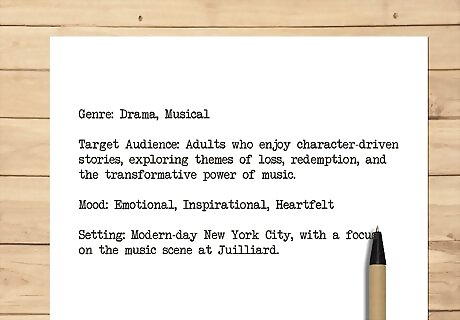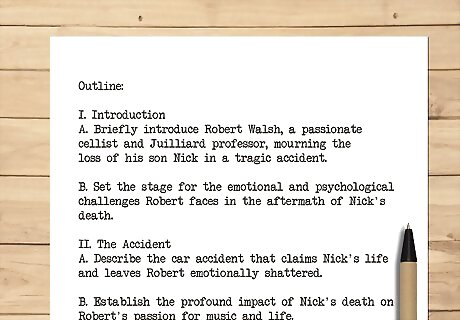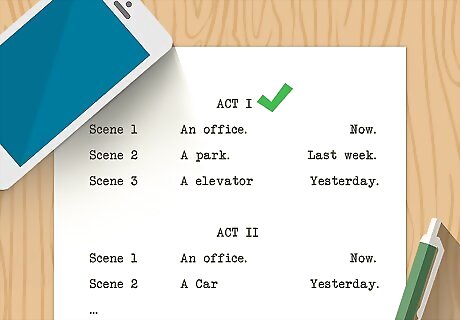
views
- Decide the genre, theme, and setting of your story. Craft your characters and what challenges and conflicts they will overcome throughout the story.
- Outline the beginning, middle, and end of your story. Roughly organize the plot points of your story into scenes and acts.
- Write your first draft and then another, following the playwriting format. Keep revising and asking for outside opinions before settling on a final version.
Developing the Story

Determine the genre and theme of your play. Some popular genres for stage plays are romance, mystery, crime, adventure, and comedy. Your theme should work within your chosen genre, but it also decides what message you want to convey. For example, common themes in Shakespeare's plays include love, power, identity, madness vs. sanity, and fate vs. free will. Consider the key takeaways you want your audience to walk away with or the question you want to plant in their mind. Choose themes that are relevant to present-day society and people, since that’s who will be watching and reading your plays.

Develop your characters. Plays are character-driven, so your characters should be believable and relatable. Choose a protagonist and identify their motivations, personality traits, and backstory. Develop antagonists that will create conflict or supporting characters that will help your character grow throughout the story. Understand your character’s motivations and what drives their behaviors: what does your character want? What will they do to get it? Make sure your character demonstrates growth throughout the story and has changed in some way by the play’s conclusion. Avoid using stereotypes or common character tropes when developing your characters. Your antagonist doesn’t have to be a person. Instead, it could be a struggle within the character’s own self (e.g., a soldier dealing with post-traumatic stress) or a conflict between the character and society (e.g., a woman fighting for her right to vote in 1918).

Craft your setting and plot. Choose your story's physical setting and time period, or where and when the story takes place. Be as specific as possible, e.g., “Dr. Wilson's Family Podiatry, next to the Hillsboro Suburban Mall, just south of town, at 3:15 pm on Good Friday” rather than simply “modern-day Tennessee.” Draft a narrative arc that includes a beginning, middle, and end. In playwriting, these stages of a story are better known as the exposition, rising action, conflict, climax, and resolution. The exposition should establish your play's setting, characters, and basic conflict. The rising action should present a deepening conflict or challenge until you reach the climax of the play, which is the tensest moment in which conflicts are fully addressed. The conflict of the play should underscore the theme and relate to the protagonist and antagonist: e.g., two brothers battling over their parents' will may highlight a theme of how grief may obscure what’s truly important. The play’s resolution should release the tension after the climax and show characters overcoming or learning to live with their conflicts.

Understand the limitations of the stage. Remember: you're not writing a movie. A play is an ongoing series of conversations between people. Plays aren’t a great medium for gun fights and car chases (although that doesn’t mean they’re impossible!). Alternatively, break from traditional theatre and write a play with impossible-to-stage scenes as a way of exploring the writing itself. If you have no plans to actually stage the play, treat it as a different form of writing a poem. Bertolt Brecht, Samuel Beckett, and Antonin Artaud were all innovators of experimental avant-garde plays who incorporated audience participation and other absurdist or surreal elements into their drama.
Outlining the Play

Outline your story. Write down the beginning, middle, and end of your play, and make notes of where major plot points and conflicts are going to happen. Note when certain characters will appear or be introduced. In addition to your main plot, add plot points for subplots that help develop the characters or keep the audience engaged.

Break up your plot into scenes and acts. Separate each important plot point into its act, and make sure your narrative arc moves forward throughout the acts. Time the breaks between each act in a compelling way to create suspense for the audience, almost like a cliffhanger before a commercial break on TV. Acts are like mini-plays within themselves, each made up of several scenes. The three-act play is most common, but one-act and five-act plays are also widely used. As you develop your scenes, give time for scene or costume changes and for actors to get to their places.
Writing & Formatting a Script

Write an exploratory draft. Feel free to write the play out of order for now. Follow your flow of inspiration and creative energy. Don't be afraid to overwrite; you can always cut things out later! Get into the habit of writing every day, even if only for 5-10 minutes. For the exploratory draft, don't worry about formatting the play or writing it "correctly." Just let out everything that needs to get out.

Make revisions to your script. Reread and revise the script as many times as you need to. Cut scenes that meander, cut characters that don’t move the plot forward, and make the play as tight and quick as possible. Go back through your drafts with a pencil. Circle any moments that pause the drama, and underline moments that move the drama forward. Cut out everything that's circled. If you end up cutting out 90% of what you've written, so be it. Fill it back in with things that move the story forward. Write as many drafts as it takes. There's no right number of drafts. Keep going until the play feels finished and satisfies your expectations.

Format your script properly. The format for playwriting follows a specific structure. Mark where different acts and scenes begin and end. Include character tags with each piece of dialogue, marked with their name in all capital letters (no need for quotation marks). Add in stage directions that specify certain character actions, like an exit or a kiss. Center act and scene headings. Center and capitalize character names. Italicize stage directions and indent them by one tab. Write small actions and minor stage directions in parentheses.

Arrange a table read or other opportunity for outside feedback. Try to set up a table read with actors or friends willing to volunteer their time. Hearing the dialogue read aloud may help you hear sticking points or areas that need revision. Reread your play from a different perspective. As an actor, would you understand your character’s motivations? As an audience member, would you be able to follow the plot of the play if you had no background knowledge? Get a fresh pair of eyes on your script. Ask a friend, family member, or fellow artist to read the script and give you constructive notes. Use these pieces of feedback to revise your script and move toward your final draft.
What is playwriting?

Playwriting creates a dramatic narrative to be used in a live production. Great playwriting uses effective dialogue, well-crafted plots, believable character development, and relevant themes to create engaging and moving stories. As opposed to writing scripts for movies or television shows, writing stage plays allows playwrights to connect with and interact with the audience immediately.

















Comments
0 comment